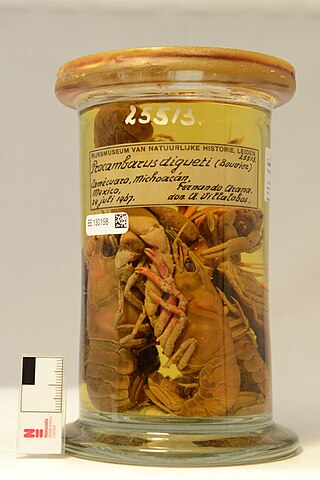
The Everglades crayfish, sometimes called the Florida crayfish, the blue crayfish, the electric blue crayfish, or the sapphire crayfish, is a species of freshwater crayfish endemic to Florida in the United States. Its natural range is the area east of St. Johns River and all of Florida from Levy County and Marion County southwards, as well as on some of the Florida Keys. It is included on the IUCN Red List as a species of Least Concern. The blue crayfish is frequently kept in a freshwater aquaria. In the wild, this species varies from brown-tan to blue, but an aquarium strain has been selectively bred to achieve a brilliant cobalt blue color.
Procambarus acherontis, the Orlando cave crayfish, is a species of crayfish in the family Cambaridae. It is endemic to Orange County and Seminole County, Florida, and is listed as an endangered species on the IUCN Red List.
Procambarus apalachicolae, the coastal flatwoods crayfish, is a species of crayfish in family Cambaridae. It is endemic to Florida, and is listed as an endangered species on the IUCN Red List.
Procambarus attiguus, known as the Silver Glen Springs cave crayfish, is a species of crayfish in the family Cambaridae. It is endemic to Silver Glen Springs, Marion County, Florida, and is listed as critically endangered on the IUCN Red List.
Procambarus barbiger, known as the Jackson prairie crayfish, is a species of crayfish in the family Cambaridae. It is endemic to Jackson Prairie in Newton County, Scott County, Jasper County, Smith County and Rankin County, Mississippi.
Procambarus brazoriensis, the Brazoria crayfish, is a species of crayfish which is endemic to Brazoria County, Texas. It is listed as an endangered species on the IUCN Red List.
Procambarus cometes, the Mississippi flatwoods crayfish is a species of crayfish in the family Cambaridae. It is endemic to Lowndes County and Oktibbeha County, Mississippi, and is listed as an endangered species on the IUCN Red List.
Procambarus delicatus, sometimes called the big-cheeked cave crayfish, is a species of crayfish in the family Cambaridae. It is endemic to a single spring in the Ocala National Forest, Lake County, Florida.
Procambarus escambiensis, sometimes called the Escambia crayfish, is a species of crustacean in family Cambaridae. It is endemic to the Escambia River system in Alabama and Florida and is listed as an endangered species on the IUCN Red List.
Procambarus gibbus, the Muckalee crayfish, is a species of crayfish in the family Cambaridae. It is endemic to the Flint River drainage in the U.S. state of Georgia. The common name of the species refers to the Muckalee Creek in Sumter County, Georgia, from where the first specimens were collected.
Procambarus leitheuseri, sometimes called the Coastal Lowland cave crayfish, is a species of troglobite crayfish in the family Cambaridae. It is endemic to Hernando and Pasco counties, Florida and is listed as an endangered species on the IUCN Red List.
Procambarus milleri, the Miami cave crayfish is a species of crayfish in the family Cambaridae. It is endemic to Florida, where it is known from 14 to 15 sites in Miami-Dade County, Florida, and is listed as an endangered species on the IUCN Red List.
Procambarus morrisi, the Putnam County cave crayfish, is a species of crayfish in the family Cambaridae. It is only known from the type locality, at the Devil's Sink, west of Interlachen, Putnam County, Florida, and is listed as critically endangered on the IUCN Red List.
Procambarus orcinus, known as the Woodville Karst cave crayfish, is a species of crayfish in the family Cambaridae. It is endemic to the Woodville Karst Plain in the United States. This species has been reported from eight solutional caves in southern Leon County as well as six caves in Wakulla County, Florida.

Procambarus digueti is a species of fresh water crayfish in the genus Procambarus and in the family Cambaridae. It is endemic to tropical regions in the Pacific Coast of Mexico. It lives in shallow lakes where oxygen is plentiful and are the only decapod species in Mexico to live in waters 1,800 meters above sea level. P. digueti is believed to be one of the oldest species of Mexican crayfish due to its unusually low genetic variability between organisms and geographical evidence. It has experienced a greater amount of habitat loss than other crayfish species have in Mexico, leading to a decline in its populations and the IUCN Red List to deem it as an endangered species.
Procambarus liberorum is a species of crayfish in the family Cambaridae. It is endemic to the United States, where it occurs in Arkansas and Oklahoma. It is known commonly as the Osage burrowing crayfish.
Procambarus regalis, sometimes called the regal burrowing crayfish, is a species of crayfish in the family Cambaridae. It is native to Texas and Arkansas, and is listed as Data Deficient on the IUCN Red List, although it may be a synonym of Procambarus steigmani.




